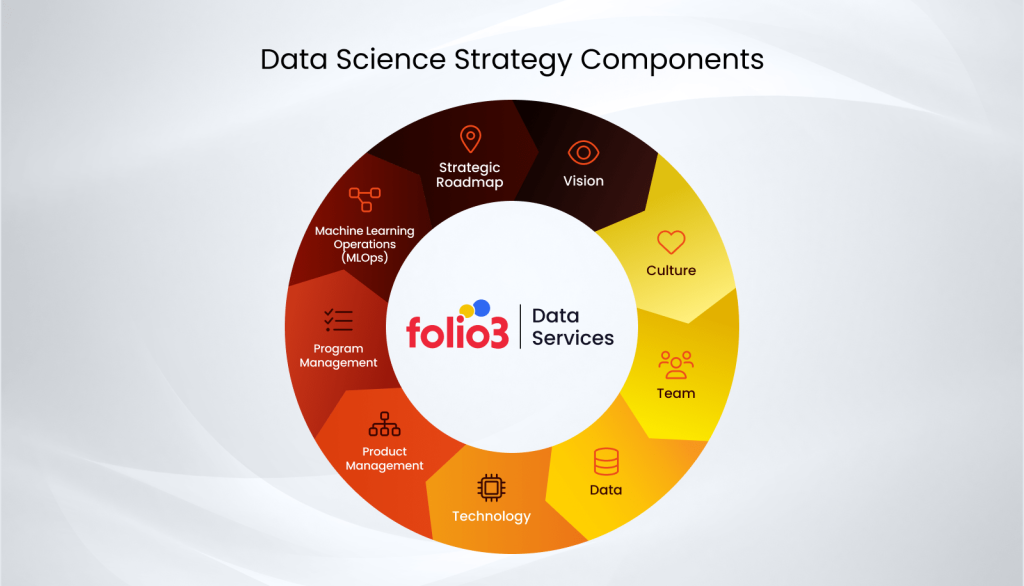Data science has emerged as a pivotal force driving industry innovation and decision-making. A well-structured strategy is essential to maximizing its potential.
This guide delves into the nine fundamental components that form the backbone of a successful data science initiative. By understanding these elements, organizations can navigate the complexities of data-driven transformation and unlock its value.
What is a Data Science Strategy?
A data science strategy is a comprehensive blueprint that outlines how an organization will use data to achieve its business goals. It goes beyond isolated analytics projects, serving as a guiding framework for the entire data journey. By aligning efforts with broader objectives, this strategic approach helps maximize competitive advantage and drive long-term value.
A well-defined data science strategy integrates various components to ensure that data-driven initiatives align with the organization’s objectives. A robust data science strategy encompasses several key elements:
- Alignment with business goals: The strategy should clearly articulate how data science will contribute to the overall business strategy.
- Data infrastructure: It defines the data ecosystem, including data sources, storage, and management processes.
- Talent and skills: It outlines the necessary data science talent and skills to execute the strategy.
- Technology stack: The strategy identifies the tools and technologies essential for data analysis, modeling, and deployment.
- Governance and ethics: It establishes guidelines for data usage, privacy, and ethical considerations.
- Performance metrics: It defines key performance indicators (KPIs) to measure the success of data science initiatives.
9 Components to Build a Successful Data Science Strategy

A robust data science strategy is a cornerstone for organizations that leverage data for competitive advantage. It requires careful consideration of several interconnected components. Let’s delve into each of these components:
1. Vision
A clear and inspiring vision outlines the desired end state of the data science initiative. It defines the overarching goals, the problems to be solved, and the value to be created. The vision should align with the organization’s broader strategic objectives and guide decision-making.
A compelling vision should:
- Align with the organization’s mission.
- Focus on successful outcomes.
- Avoid technical or business jargon.
- Be supported by mission statements and value philosophies that define the “why,” “how,” and “what” of your strategy.
- Take into account a data protection strategy to help safeguard sensitive information and enable responsible, compliant data usage.
The vision is the foundation for the entire strategic plan, guiding the development and implementation of all other components.
2. Culture
A data-driven culture is essential for the success of any data science initiative. It fosters a mindset of experimentation, innovation, and collaboration. Encouraging data literacy, promoting data-driven decision-making, and recognizing data science achievements are crucial to building a supportive culture.
According to the NewVantage Partners Big Data and AI 2021 Survey, 92.2% of leading companies face cultural challenges. An effective data science strategy should:
- Identify and address industry-wide and organization-specific cultural challenges, such as organizational alignment, business processes, change management, communication, skillsets, and resistance to change.
- Leverage cultural strengths that support data-driven adoption, considering organizational values, mission, and individual motivators.
- Implement tactics to foster a data-driven culture, such as data science clubs, lunch and learns, dev discussions, hands-on labs, recruitment events, dedicated chat/support rooms, and support from internal communications.
3. Team
Assembling a skilled and diverse data science team is paramount. The team should comprise data scientists, engineers, analysts, and domain experts. Effective collaboration and communication within the team are vital in driving successful projects.
Key considerations include:
- Identifying who is responsible for the vision and execution (e.g., Chief Data Officer, Data Science Team Manager, Chief Information Officer).
- Determining whether a centralized or decentralized data science function is more effective.
- To ensure a collaborative approach, assemble a diverse team, including data scientists and other essential roles.
4. Data
High-quality data is the lifeblood of data science. Identifying, collecting, cleaning, and preparing relevant data is critical. A strong data governance strategy helps enable these processes by ensuring data accuracy, consistency, and security.
Data is often regarded as the world’s most valuable resource. An effective data strategy should support data capture, storage, and retrieval, addressing:
- Data governance issues such as ethical data use.
- Making data FAIR (Findable, Accessible, Interoperable, Reusable)
5. Technology
The right technology stack is crucial for efficient data processing, analysis, and model development. This includes data storage, processing frameworks, machine learning libraries, and cloud platforms.
The tech stack for data science is constantly evolving. An effective technology strategy should:
- Establish a plan to discover, vet, purchase, and maintain an evolving tech stack.
- Provide machine learning tools and computational resources for data professionals.
- Enable end-users to access results.
- Outline vendor management, standardize toolsets, drive cloud-native adoption, handle security risks, train end-users, and define standard protocols.
6. Product Management
Product management is vital in translating business needs into data science projects. They define product requirements, prioritize features, and ensure alignment with the business strategy.
Data science product management helps prioritize opportunities and focus on the most impactful projects. A data science strategy should outline the following:
- The type of research and products to be delivered.
- A discovery and prioritization process for data science investments.
- Fundamental principles for effective product management.
7. Program Management
Effective program management oversees the entire data science lifecycle, from project initiation to deployment and maintenance. It involves resource allocation, risk management, and stakeholder communication.
Data science projects differ from software projects. A data science strategy should define the following:
- A data science life cycle outlining necessary steps for project delivery.
- A collaboration framework guiding team communication and coordination.
- A comprehensive process combining the life cycle and collaboration framework.
- Agile principles for incremental value delivery.
- Repeatable processes that are manageable.
8. Machine Learning Operations (MLOps)
MLOps focuses on the deployment and management of machine learning models in production. It includes monitoring model performance, retraining, and ensuring continuous delivery of data science solutions.
Maintaining and sustaining value from machine learning models requires a specialized approach. A machine learning operations strategy should focus on the following:
- Operational strategy and processes.
- Cloud systems management.
- Data management.
- Model management.
Data lake consulting can be a key asset during this process, helping organizations design and optimize their data lakes to enable reliable, scalable storage and access for training and operational workloads.
9. Strategic Roadmap
A well-defined strategic roadmap outlines the long-term vision for the data science initiative. It sets clear milestones, identifies key performance indicators (KPIs), and allocates resources accordingly.
Regular evaluation and adjustment of the roadmap are essential to adapt to changing business needs and technological advancements. A data strategy roadmap helps prioritize and sequence the implementation of the strategic plan, ensuring that initiatives align with broader business goals. It should:
- Prioritize specific elements of the plan.
- Lay out a timeline to communicate priorities and expectations.
- Be dynamic, updated regularly to reflect current realities and re-shuffled priorities.

How to Create A Successful Data Science Strategy? – 4 Steps for a Successful Data Science Strategy
Developing an effective data science strategy requires a clear plan and focused actions. Here are three key steps to ensure your strategy is both successful and sustainable:

1. Align with the Right Vendor
Partnering with a suitable vendor is crucial for a successful data science strategy. This collaboration can provide your team with the necessary support and expertise, including data engineering services, to navigate complex data science challenges effectively.
How to Choose the Right Vendor?
- Understand Business Specifics: Look for a vendor who understands your industry’s unique needs and challenges.
- Alignment with Objectives: Ensure the vendor’s goals and methods align with your business objectives.
- Experience and Expertise: The vendor should have relevant experience and a proven track record in handling similar projects.
- Commitment to Communication: Choose a vendor who values open and continuous communication.
- Focus on Continuous Growth: Select a vendor committed to staying current with data science and AI advancements, ensuring they can support your evolving needs.
2. Gather and Track the Right Metrics
To ensure your data science strategy delivers long-term value, you must identify and monitor key performance indicators (KPIs) aligning with your strategic goals.
Key Metrics to Track
- Component Reuse: Measure the reuse of data science components, such as models, data sets, and templates. This promotes efficiency, speeds up future projects, and reduces the likelihood of errors.
- Team Productivity: Set and track targets for your team’s productivity. This can include metrics like the volume of data processed, the accuracy of models, or the number of successful deployments.
- Return on Investment (ROI): Evaluate the financial benefits of your data science initiatives compared to the costs incurred.
- Model Performance: Track the accuracy, precision, recall, and other performance metrics of your predictive models.
3. Set Use-Case-Driven Goals and Demonstrate Valuable Results
Defining specific, actionable goals based on real-world use cases helps drive your data science strategy forward. These goals should be operational and aligned with your long-term strategic vision.
Examples of Use-Case-Driven Goals
- Increase Sales: Aim to boost sales compared to previous periods through targeted marketing and personalized recommendations.
- Train on New Algorithms: Invest in training your data science team on the latest machine learning algorithms to enhance their skill set and improve model performance.
- Optimize Operations: Implement predictive maintenance to reduce downtime and increase operational efficiency.
Demonstrating Results
- Set Milestones: Break down long-term goals into smaller, achievable milestones that can be tracked daily or weekly.
- Communicate Successes: Regularly update stakeholders on progress and successes, using dashboards and reports to visualize data.
- Iterate and Improve: Use feedback from achieved milestones to refine and improve your data science processes and models.
4. Create a Data Strategy Template
To keep your data science strategy focused and organized, create a template outlining your plan’s essential elements.
Critical Elements of a Data Strategy Template
- Use Cases: Identify and describe specific business problems and opportunities your data science initiatives will address.
- Goals: Set clear, measurable goals that align with your business objectives.
- Data Requirements: Define the data sources, data quality standards, and governance policies needed. Partnering with experienced data integration consultants can help ensure that data from various sources is seamlessly connected and meets quality requirements.
- Technology: Outline the tools, platforms, and infrastructure required to support your data science efforts.
- Skills and Team: Detail the skills needed and the roles and responsibilities of team members.
- Roadmap: Develop a timeline with milestones and deliverables to guide the implementation of your strategy.
What Makes A Data Science Strategy Successful?
A successful data science strategy involves a complex interplay of applications, tools, algorithms, and processes. These elements work in tandem to extract value from data and drive business outcomes. A robust data science strategy can be a transformative organizational asset in every sector, from healthcare to retail.
By employing robust analysis techniques, leveraging technologies like artificial intelligence and machine learning, and utilizing statistics and software, businesses can design and execute plans, projects, and programs that benefit their operations and customers. Data strategy services can aid organizations in developing, refining, and optimizing these strategies, ensuring they align with business goals and maximize the value of their data.
While individual industries require unique approaches, several standard data science components are essential to successful data science business strategies. These components include applications and tools, algorithms, and processes—all providing vital insights, driving data-informed decision-making, and contributing to company success.
Applications and Tools
Data science applications and tools empower organizations to discover crucial information about their products, services, employees, customers, and competition. Critical applications include pattern recognition and predictive modeling, which organize and analyze data in practical, understandable ways.
Pattern Recognition
Pattern recognition is fundamental to data science. It enables the identification of recurring patterns in data sets. This application has diverse uses across industries, offering valuable business intelligence to leaders and stakeholders.
An enterprise data strategy guides organizations in effectively harnessing these patterns to drive smarter decisions and maximize the value of their data.
- Agriculture: The Small Robot Company developed a robot that uses pattern recognition to identify and eliminate broad-leaved weeds, keeping crops healthy and allowing human labor to focus on other tasks.
- Oil and Gas: Operational AI company Falkonry used pattern recognition to identify operational patterns that preceded critical failures in compressors and turbines. This enabled their client to predict failures six weeks before, preventing significant financial losses.
- Technology: Descript, an audio word processor, adopted Google Cloud’s Speech-to-Text tool, which recognizes speech patterns and provides highly accurate transcripts within minutes.
Predictive Modeling
Predictive modeling tools project future outcomes through data analysis and are essential across various industries. Data analytics services help organizations make the most of these tools by turning raw data into actionable insight.
- Ticket Sales: StubHub used predictive analytics tools to analyze customer data, calculate the lifetime value of 180 million customers, and reduce fraud issues by up to 90%.
- Public Schools: The Des Moines Public School District implemented a predictive analytics “dropout prevention” model, enabling teachers to identify at-risk students and adjust their teaching methods accordingly.
- Food and Beverage: Kerry, a food and beverage producer, used a predictive analytics AI tool to shorten the concept generation timeline from weeks to days and reduce the product development timeline from months to less than two months.
Algorithms
Choosing the suitable algorithms is crucial to constructing an effective data science strategy. Data scientists must be familiar with various machine-learning algorithms to select the best option for each project. When used effectively, algorithms provide vital insights and promote data-driven decisions.
- Criminal Justice: The New Jersey Court System used algorithms to manage pretrial defendants’ risk, reducing the jail population by 40% and saving $10 million without increasing the crime rate.
- Financial Services: Algoan used machine learning algorithms to streamline the credit scoring and loan application process, reducing decision times from days to minutes while maintaining efficiency and security.
- Healthcare: The American Cancer Society used deep learning algorithms to analyze breast cancer tissue images 12 times faster, improving quality and accuracy.
- Technology and Manufacturing: Augury used AI and IoT algorithms to reduce machine failure by 75%.
- Media and Entertainment: Bonnier Publications used machine learning algorithms to model consumer behavior, increasing e-commerce conversions by 18%, gaining 50,000 new subscribers, and reducing banner ads by 90%.
Processes
Data science involves six key processes that form a comprehensive workflow: discovery, data preparation, model planning, model building, operationalizing, and communicating results.
Discovery
In the discovery phase, data relevant to the business question is gathered. Data scientists use discovery tools to explore data through graphs, charts, and datasets. This phase provides insights into various aspects, such as customer conversion rates in retail, appointment times in healthcare, or product lifecycle data in manufacturing. Staying up to date with data analytics trends during this process helps organizations identify new opportunities and uncover patterns that may otherwise go unnoticed.
Preparation
Data often contains inconsistencies that need to be addressed before analysis. The preparation phase involves cleaning and formatting data to ensure high-quality predictions.
Model Planning
Data scientists use various methods to determine relationships between variables. Tools and programming languages like SQL, statistical formulas, and R are used to plan models.
Model Building
Models are built and tested using various tools and techniques. Data scientists apply classification techniques to training datasets and use languages like Python to validate models against test datasets. A strong customer data strategy guides this process by ensuring that the most relevant and high-value customer information is used to produce accurate and actionable models.
Operationalizing
Once tested, models are deployed in real-world environments during the operationalizing phase.
Communicating Results
The final phase involves evaluating whether the model answered the business question and communicating findings. Results are shared through dashboards and visual representations to ensure clarity and accuracy, guiding organizational decisions.

Conclusion
A successful data science strategy is a multifaceted endeavor that requires a harmonious blend of people, processes, and technology. By understanding the interplay of pattern recognition, predictive modeling, and algorithmic choices, organizations can unlock the potential of their data.
A structured approach encompassing discovery, preparation, model building, and deployment is essential for deriving actionable insights. Effectively communicating results is the key to translating data-driven findings into tangible business value.
So, If you’re seeking a reliable partner to navigate the complexities of cloud and data, Folio3 is worth considering. Their expertise and commitment to customer success make them a valuable asset for businesses of all sizes.
FAQs
A data scientist is a critical player in a data science strategy. They are responsible for exploring data, building models, and extracting meaningful insights. Their role involves collaborating with business stakeholders to understand their needs, selecting appropriate algorithms, and developing solutions that drive business value.
Measuring the success of a data science strategy involves defining and tracking key performance indicators (KPIs) aligned with business objectives. These metrics include revenue growth, cost reduction, customer satisfaction, and operational efficiency. Establishing a baseline and tracking improvements over time is essential.
Data quality, talent scarcity, cultural integration, resistance to change, and privacy concerns hinder the implementation of a data science strategy.
Cloud computing provides scalable and cost-effective data storage, processing, and analysis infrastructure. It enables organizations to access advanced computing resources without significant upfront investments. Cloud platforms also offer a range of data science tools and services.





